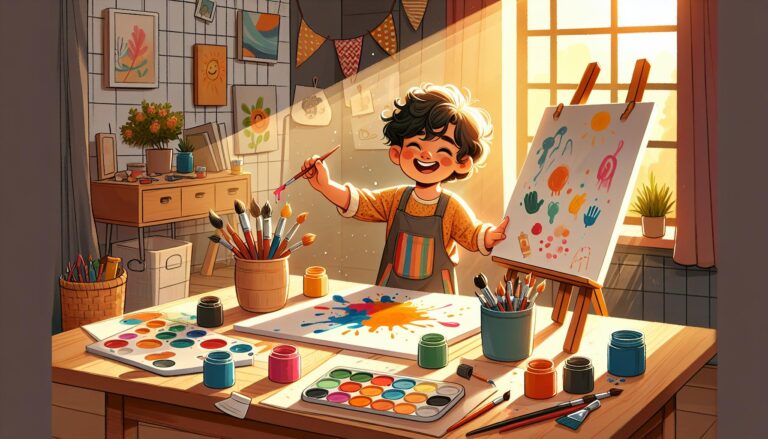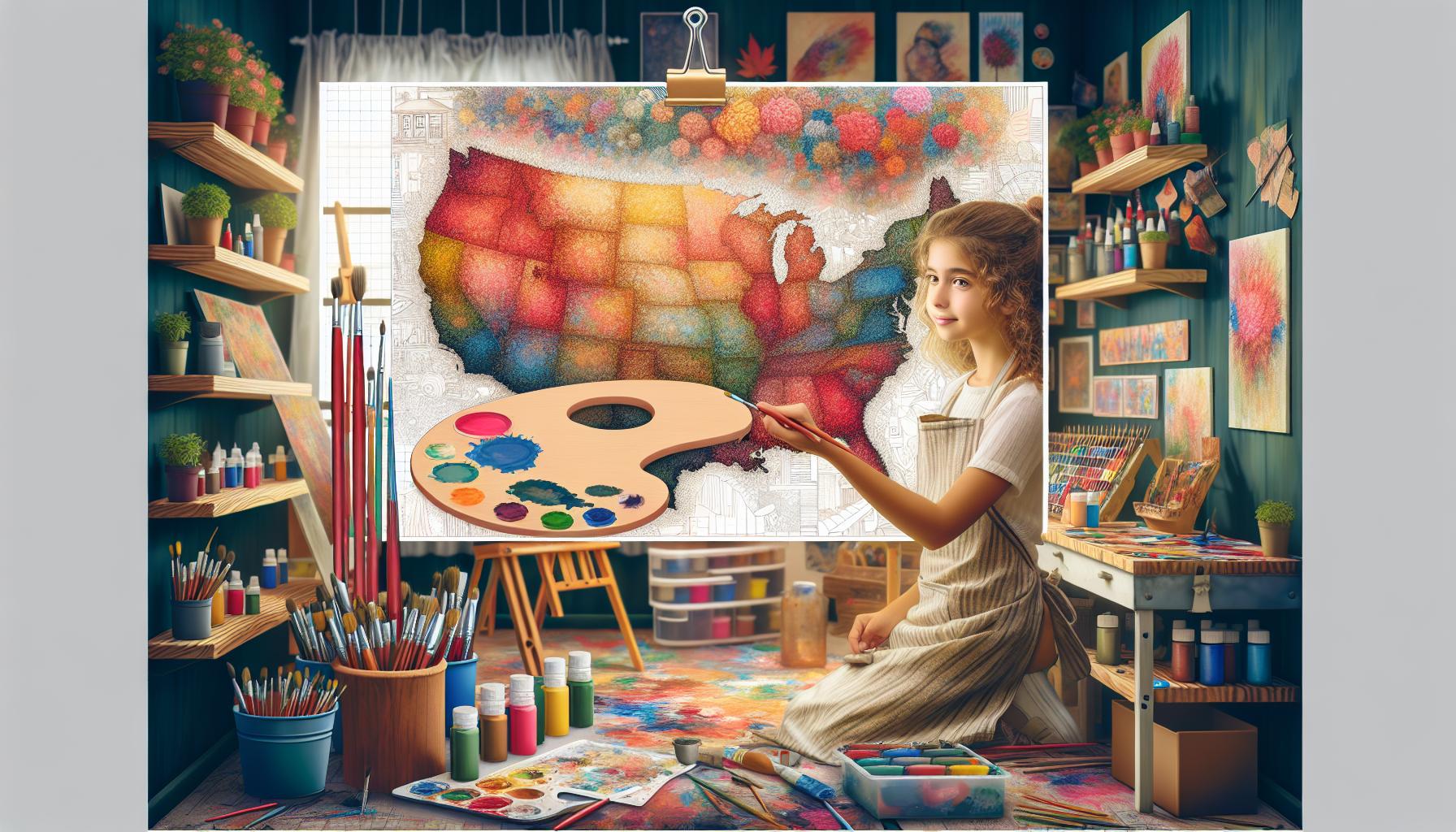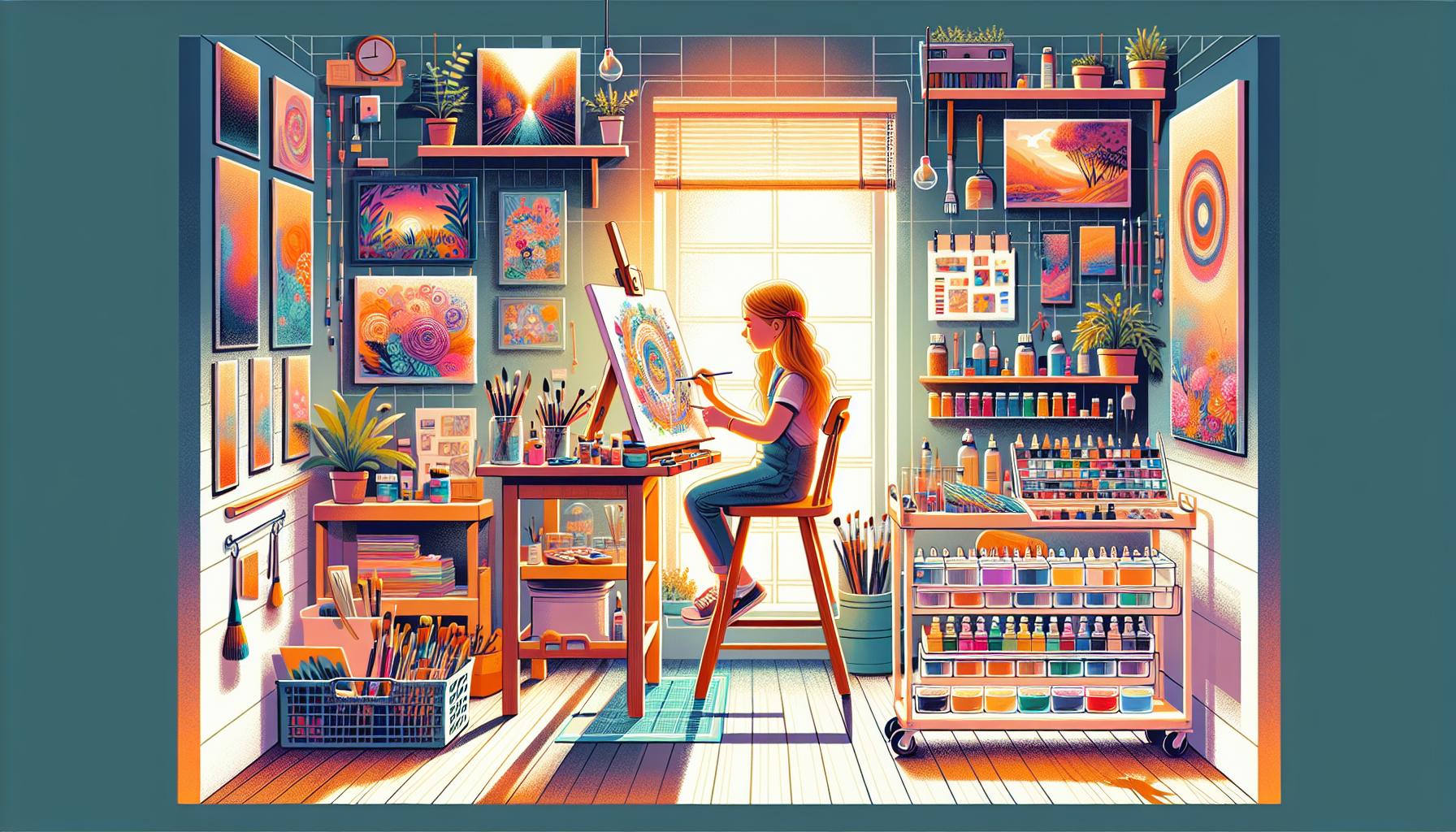
We understand that bringing arts education into your homeschool journey can feel overwhelming at first. From selecting the right art supplies to planning creative lessons your kids will love, there’s a lot to consider. But teaching art at home offers incredible benefits for your child’s development and self-expression.
Looking for ways to spark creativity in your homeschool curriculum? Art education goes beyond just drawing and painting – it helps develop problem-solving skills critical thinking and emotional intelligence. Whether you’re just starting out or wanting to enhance your existing arts program we’ll explore practical tips and inspiring ideas to make arts education a natural part of your homeschool day.
Key Takeaways
- Arts homeschooling combines creative expression with core academics, leading to improved cognitive development, test scores, and problem-solving skills.
- A comprehensive arts curriculum should include visual arts, performing arts, and music/dance education, with regular practice sessions of 20-30 minutes per discipline.
- Creating a dedicated arts space with proper lighting, storage solutions, and performance areas is essential for an effective home arts education environment.
- Students benefit from both online platforms and local community resources, including virtual classes, museum programs, and artist mentorship opportunities.
- Regular assessment through portfolios, performance evaluations, and skill reviews helps track artistic progress while maintaining enthusiasm for creative learning.
- College-bound arts students should start building comprehensive portfolios by freshman year and meet both academic and arts-specific requirements for their chosen programs.
Understanding Arts Homeschooling
Arts homeschooling combines creative expression with academic learning in a home environment. This educational approach integrates visual arts, music, dance, drama or other creative disciplines into daily lessons.
Benefits of Arts-Focused Home Education
Arts education at home enhances cognitive development through multiple learning pathways. Students who practice art show improved:
- Memory retention through hands-on creative activities
- Problem-solving skills via artistic challenges
- Fine motor coordination from drawing, painting or sculpting
- Self-expression abilities through various art mediums
- Cultural awareness by studying art history
- Math comprehension through spatial relationships
- Language skills via art discussions
Research indicates that children involved in regular arts activities score 15% higher on standardized tests compared to peers without arts exposure.
| Skill Area | Improvement % |
|---|---|
| Critical Thinking | 25% |
| Memory Retention | 20% |
| Test Scores | 15% |
| Motor Skills | 18% |
Different Approaches to Arts Education at Home
Several effective methods exist for incorporating arts into home education:
- Project-Based Learning
- Creating art portfolios
- Organizing exhibitions
- Developing themed art series
- Integration Method
- Adding drawing to science observations
- Using music in history lessons
- Incorporating drama into literature studies
- Structured Curriculum
- Following systematic art programs
- Taking online art classes
- Participating in virtual museum tours
- Free Expression
- Setting up dedicated art spaces
- Providing open-ended materials
- Encouraging daily creative time
- Student’s age
- Learning style
- Artistic interests
- Available resources
- Time constraints
Essential Components of an Arts Homeschool Program

An effective arts homeschool program integrates diverse creative disciplines to foster comprehensive artistic development. These components create a balanced foundation for students to explore multiple forms of artistic expression.
Visual Arts Curriculum
A comprehensive visual arts curriculum incorporates drawing, painting, sculpture, and digital art techniques. Students learn color theory, composition principles, and art history through hands-on projects and masterwork studies. Core supplies include:
- Drawing materials: graphite pencils, charcoal, colored pencils
- Painting supplies: watercolors, acrylics, brushes, papers
- 3D materials: clay, wire, recycled items for sculpture
- Digital tools: graphic design software, drawing tablets
- Art history resources: prints, books, online galleries
Performing Arts Integration
Performing arts build confidence, communication skills, and creative expression through theater and dramatic activities. Key elements include:
- Drama exercises: improvisation games, character development, script analysis
- Public speaking practice: monologues, poetry recitation, storytelling
- Technical theater skills: set design, costume creation, lighting basics
- Performance opportunities: home productions, community theater, virtual showcases
- Literature connections: play reading, script writing, dramatic interpretation
Music and Dance Education
Music and dance programs develop rhythm, coordination, and artistic expression through structured lessons and creative movement. Essential components include:
- Music fundamentals: note reading, rhythm training, ear training
- Instrument options: piano, guitar, recorder, percussion
- Movement basics: ballet positions, modern dance, folk dances
- Rhythm activities: body percussion, musical games, dance compositions
- Performance elements: recitals, recordings, dance showcases
- Music appreciation: composer studies, concert viewing, style analysis
Each activity incorporates age-appropriate materials and builds skills progressively. Regular practice sessions of 20-30 minutes maintain steady progress, while quarterly showcases celebrate student achievements.
| Art Form | Weekly Practice Time | Skill Development Areas |
|---|---|---|
| Visual Arts | 3-4 hours | Fine motor, spatial awareness, creativity |
| Performing Arts | 2-3 hours | Communication, confidence, expression |
| Music & Dance | 3-4 hours | Rhythm, coordination, musicality |
Creating an Arts-Rich Learning Environment

An arts-rich learning environment sparks creativity and facilitates effective artistic education at home. The right setup transforms ordinary spaces into inspiring areas for artistic exploration and creative expression.
Setting Up a Home Art Studio
A dedicated art studio starts with proper lighting – both natural and artificial sources positioned to eliminate shadows on work surfaces. Here’s what creates an effective home art studio:
- Install adjustable task lighting above workstations
- Place tables near windows to maximize natural light
- Set up washable floor coverings to protect against spills
- Create organized storage zones for different media types
- Mount pegboards or shelving units for easy supply access
- Add a cleanup station with sink access or portable washing setup
Storage solutions make supplies accessible while keeping the space tidy:
- Clear containers to store brushes paints markers
- Rolling carts with multiple drawers for paper supplies
- Vertical files for artwork storage
- Wall-mounted drying racks for completed pieces
- Labeled bins for different materials like clay fabric beads
Organizing Performance Spaces
Performance areas require flexible configurations that adapt to different artistic activities. Key elements of an effective performance space include:
- Open floor area (minimum 8×10 feet) for movement activities
- Portable mirrors for dance or drama practice
- Sound system with speakers for music playback
- Storage for props costumes musical instruments
- Adequate ventilation for physical activities
- Non-slip flooring or removable dance mats
- Rolling furniture for quick space reconfiguration
- Folding screens to define separate practice areas
- Wall-mounted bars for dance support
- Stackable cushions for audience seating
- Portable lighting options for performances
- Sound-dampening curtains or panels
Finding Arts Resources and Materials
Arts education resources add enrichment to homeschooling through diverse learning platforms, community connections, and quality materials. Let’s explore the key sources for building a comprehensive arts education program.
Online Arts Education Platforms
Digital platforms expand arts education opportunities through interactive lessons and virtual galleries. Popular platforms offer:
- Live-streamed art classes with professional instructors
- Downloadable lesson plans for different age groups
- Video tutorials covering painting, drawing, sculpture techniques
- Virtual museum tours featuring masterpiece collections
- Interactive music theory courses with practice exercises
- Digital workspaces for student portfolio development
The top platforms include:
| Feature | Basic Plan | Premium Plan |
|---|---|---|
| Monthly Cost | $15-25 | $35-50 |
| Live Classes | 2-3/month | Unlimited |
| Lesson Downloads | 10/month | Unlimited |
| Student Portfolios | 1 GB storage | 10 GB storage |
Local Arts Communities and Programs
Community resources create hands-on learning experiences through direct interaction with artists and art spaces:
- Museum education programs offering guided tours and workshops
- Community theaters providing acting classes and performance opportunities
- Local art centers hosting regular children’s workshops
- Artist cooperatives teaching specialized techniques
- Libraries organizing art-focused reading groups and activities
- Music schools offering instrument rentals and group lessons
Connection opportunities include:
- Monthly art walks showcasing student work
- Seasonal art fairs for networking
- Group critiques with professional artists
- Collaborative projects with other homeschool families
- Artist mentorship programs
| Program Type | Average Cost | Group Discount |
|---|---|---|
| Art Classes | $45/session | 25% off |
| Music Lessons | $60/hour | 20% off |
| Theater Workshop | $200/8 weeks | 30% off |
Evaluating Your Child’s Artistic Progress
Tracking artistic development helps identify growth areas and celebrate achievements in arts homeschooling. Regular assessment creates opportunities to refine teaching methods and adjust curriculum pacing based on individual progress.
Portfolio Development
A digital or physical portfolio documents your child’s artistic journey through carefully selected works. Here’s how to create an effective portfolio:
- Collect dated samples monthly to show progression
- Photograph 3D artwork like sculptures and installations
- Include project descriptions that detail techniques learned
- Store works chronologically in acid-free folders or digital files
- Add student reflections about creative choices and challenges
- Document practice sessions and performance recordings
- Maintain separate sections for different art forms (visual, music, dance)
Performance Assessments
Performance assessments measure practical skills and creative growth through:
Skills Evaluation:
- Track mastery of specific techniques
- Monitor improvement in artistic elements (composition, rhythm, movement)
- Note increased complexity in projects
- Document time management and task completion
Creative Development:
- Observe problem-solving approaches
- Record artistic risk-taking and experimentation
- Note growth in self-expression
- Track participation in collaborative projects
- Monthly skill-specific rubrics
- Video progress recordings
- Written self-evaluations
- Quarterly showcase presentations
- Peer feedback sessions
- Professional instructor reviews
| Assessment Type | Frequency | Documentation Method |
|---|---|---|
| Skill Reviews | Monthly | Rubric Checklist |
| Performance Records | Bi-weekly | Video/Audio Files |
| Self-Reflection | Weekly | Journal Entries |
| Showcase Events | Quarterly | Portfolio Updates |
These evaluation methods create a comprehensive picture of artistic development while maintaining enthusiasm for creative exploration.
Preparing for College and Careers in the Arts
Arts homeschooling creates a strong foundation for students pursuing higher education or professional artistic careers. The key lies in strategic preparation through portfolio development and understanding college requirements.
Building a Strong Arts Portfolio
An arts portfolio showcases a student’s best work and artistic growth over time. Start collecting portfolio pieces by the freshman year of high school, including 15-20 samples across different mediums. Include:
- High-resolution photographs of physical artwork
- Digital copies of graphic design projects
- Video recordings of performances or choreography
- Audio recordings of musical compositions
- Sketches showing the creative process
- Artist statements for major works
Create a digital backup of all portfolio materials using cloud storage platforms. Update the portfolio quarterly, replacing older works with newer pieces that demonstrate improved skills.
Meeting College Requirements
Art colleges maintain specific admission criteria beyond standard academic requirements. Common prerequisites include:
Academic Requirements:
- 4 years of English
- 3-4 years of Math
- 3 years of Science
- 2-3 years of Foreign Language
- 3-4 years of Social Studies
Arts-Specific Requirements:
- 2-3 years of concentrated study in chosen art form
- Private lessons documentation
- Performance or exhibition history
- Technical proficiency demonstrations
- Theory coursework completion
| Requirement Type | Typical Hours Needed | Documentation Required |
|---|---|---|
| Studio Art | 720-900 hours | Portfolio + Course logs |
| Music | 800-1000 hours | Recordings + Recital programs |
| Dance | 600-800 hours | Performance videos + Training records |
| Theater | 500-700 hours | Production photos + Performance videos |
Connect with admissions officers at target schools to understand specific program requirements. Schedule portfolio reviews with professional artists or arts educators for feedback before submission deadlines.
Conclusion
We’ve explored how arts homeschooling opens up a world of creative possibilities for our children’s education. The journey of integrating arts into home learning brings both challenges and rewards that shape our children’s development in remarkable ways.
By creating dedicated spaces setting clear goals and maintaining consistent documentation we set our young artists up for success. Whether they’re destined for art school or simply enriching their lives through creative expression we’re equipping them with valuable skills that extend far beyond the canvas.
The path of arts education at home isn’t always straightforward but the rewards of watching our children flourish creatively make every effort worthwhile. Let’s embrace this journey of artistic discovery and watch as our children’s creativity takes flight.
Frequently Asked Questions
How does arts education benefit homeschooled children?
Arts education enhances creativity, problem-solving skills, and emotional intelligence in homeschooled children. Research shows students engaged in regular arts activities score 15% higher on standardized tests. It also improves memory retention, fine motor coordination, cultural awareness, math comprehension, and language skills through integrated learning experiences.
What are the essential components of an arts homeschool program?
A comprehensive arts homeschool program should include visual arts (drawing, painting, sculpture), performing arts (drama, public speaking), and music/dance education. The program should be age-appropriate, provide regular practice sessions, and include quarterly showcases to celebrate achievements. All components should progressively build skills over time.
How do I set up an effective home art studio?
Create a dedicated space with proper lighting, organized storage solutions, and a cleanup station. For performing arts, include open floor areas, portable mirrors, and a sound system. Ensure flexible furniture arrangements to accommodate various artistic activities. The space should inspire creativity and facilitate effective learning.
What resources are available for arts education at home?
Resources include online platforms offering live-streamed classes, downloadable lesson plans, video tutorials, and virtual museum tours. Local resources encompass community theaters, art centers, museum education programs, and artist cooperatives. Many organizations offer special discounts for homeschoolers.
How can I track my child’s artistic progress?
Create a digital or physical portfolio documenting your child’s artistic journey, including dated samples, photographs of work, and project descriptions. Use rubrics and video recordings for performance assessments. Include student reflections and self-evaluations to provide a comprehensive picture of artistic growth.
What should I consider when preparing for art college?
Focus on building a strong portfolio with high-resolution photographs, digital copies, and artist statements. Research specific college requirements for both academic and artistic submissions. Connect with admissions officers and seek professional feedback on portfolios. Keep the portfolio updated regularly.
How can I integrate arts with other academic subjects?
Combine arts with core subjects through project-based learning and cross-disciplinary activities. For example, use drawings to illustrate scientific concepts, create historical dramatizations, or explore geometric principles through sculpture. This integration enhances understanding and retention of both artistic and academic concepts.
How much time should be devoted to arts education daily?
Dedicate 30-60 minutes daily for focused arts education, depending on your child’s age and interest level. This can be flexible and integrated throughout other subjects. Regular, consistent practice is more beneficial than occasional lengthy sessions.

